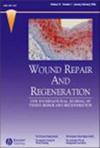异质性伤口微生物群随伤口护理疼痛、敷料类型和炎症基因表达而变化
IF 3.8
3区 医学
Q2 CELL BIOLOGY
引用次数: 0
摘要
伤口换药是伤口管理的基本程序。然而,尽管有镇痛药物可供选择,但仍有约 50% 的患者在换药过程中感到剧烈疼痛,这表明需要新型疗法来解决疼痛的根本原因。除了其他临床因素外,伤口病原体和炎症免疫反应也与伤口疼痛有关。为了测试这些因素是否会导致伤口换药时的剧烈疼痛,我们对研究对象换药时的 445 处伤口的患者报告疼痛、炎性免疫反应和伤口微生物组组成进行了探索性横断面分析。我们使用 16S 核糖体 RNA 扩增片测序分析了 406 处伤口的细菌组成,并使用定量实时聚合酶链反应(qPCR)量化了伤口液体中 13 种炎症标记物的基因表达。炎症基因表达和临床观察到的炎症均与剧烈疼痛无关,但在报告剧烈疼痛的患者伤口中,棒状杆菌和链球菌的相对丰度低于报告轻微疼痛或无疼痛的患者。伤口微生物组的组成因伤口位置而异,并与六种炎症标志物相关,包括补体受体 C5AR1、促炎细胞因子白细胞介素 (IL)1β、趋化因子 IL-8、基质金属蛋白酶 MMP2 和编码 cathelicidin 抗菌肽的抗菌肽。有趣的是,我们发现伤口微生物组与真空辅助伤口闭合(VAC)之间存在关系。这些研究结果初步确定了伤口微生物群与宿主因素之间的关联关系,有助于今后研究伤口护理疼痛、伤口闭合技术和伤口微生物群之间的定向关系。本文章由计算机程序翻译,如有差异,请以英文原文为准。
The heterogeneous wound microbiome varies with wound care pain, dressing type, and inflammatory gene expression
Wound dressing changes are essential procedures for wound management. However, ~50% of patients experience severe pain during these procedures despite the availability of analgesic medications, indicating a need for novel therapeutics that address underlying causes of pain. Along with other clinical factors, wound pathogens and inflammatory immune responses have previously been implicated in wound pain. To test whether these factors could contribute to severe pain during wound dressing changes, we conducted an exploratory, cross‐sectional analysis of patient‐reported pain, inflammatory immune responses, and wound microbiome composition in 445 wounds at the time of a study dressing change. We profiled the bacterial composition of 406 wounds using 16S ribosomal RNA amplicon sequencing and quantified gene expression of 13 inflammatory markers in wound fluid using quantitative real‐time polymerase chain reaction (qPCR). Neither inflammatory gene expression nor clinically observed inflammation were associated with severe pain, but Corynebacterium and Streptococcus were of lower relative abundance in wounds of patients reporting severe pain than those reporting little or no pain. Wound microbiome composition differed by wound location, and correlated with six of the inflammatory markers, including complement receptor C5AR1, pro‐inflammatory cytokine interleukin (IL)1β, chemokine IL‐8, matrix metalloproteinase MMP2, and the antimicrobial peptide encoding cathelicidin antimicrobial peptide. Interestingly, we found a relationship between the wound microbiome and vacuum‐assisted wound closure (VAC). These findings identify preliminary, associative relationships between wound microbiota and host factors which motivate future investigation into the directional relationships between wound care pain, wound closure technologies, and the wound microbiome.
求助全文
通过发布文献求助,成功后即可免费获取论文全文。
去求助
来源期刊

Wound Repair and Regeneration
医学-皮肤病学
CiteScore
5.90
自引率
3.40%
发文量
71
审稿时长
6-12 weeks
期刊介绍:
Wound Repair and Regeneration provides extensive international coverage of cellular and molecular biology, connective tissue, and biological mediator studies in the field of tissue repair and regeneration and serves a diverse audience of surgeons, plastic surgeons, dermatologists, biochemists, cell biologists, and others.
Wound Repair and Regeneration is the official journal of The Wound Healing Society, The European Tissue Repair Society, The Japanese Society for Wound Healing, and The Australian Wound Management Association.
 求助内容:
求助内容: 应助结果提醒方式:
应助结果提醒方式:


